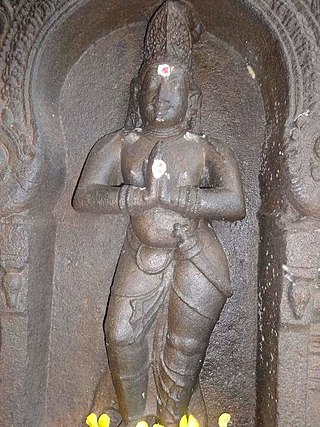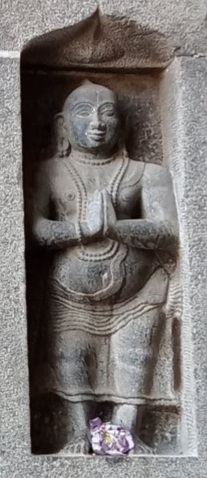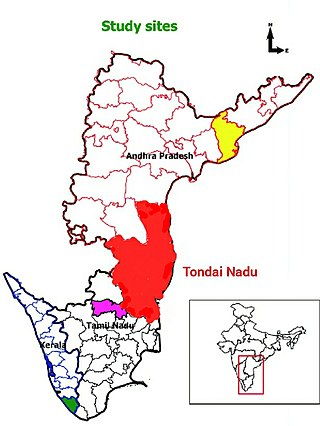
The Pandyan dynasty, also referred to as the Pandyas of Madurai, was an ancient Tamil dynasty of South India, and among the four great kingdoms of Tamilakam, the other three being the Pallavas, the Cholas and the Cheras. Existing since at least the 4th to 3rd centuries BCE, the dynasty passed through two periods of imperial dominance, the 6th to 10th centuries CE, and under the 'Later Pandyas'. Under Jatavarman Sundara Pandyan I and Maravarman Kulasekara Pandyan I, the Pandyas ruled extensive territories including regions of present-day South India and northern Sri Lanka through vassal states subject to Madurai. Pandya dynasty is the longest ruling dynasty in the world.

Jatavarman Sundara I, also known as Sadayavarman Sundara Pandyan, was an emperor of the Pandyan dynasty who ruled regions of Tamilakam, Northern Sri Lanka, and Southern Andhra between 1250–1268 CE. He is remembered for his patronage of the arts and Dravidian architecture, along with refurbishment and decoration of many Kovils (temple) in the Tamil continent. He oversaw a massive economic growth of the Pandyan empire. On the eve of his death in 1268 CE, the second Pandyan empire's power and territorial extent had risen to its zenith till Nellore and Kadapa by defeating Telugu Chola rulers Vijaya Gandagopala, Manumasiddhi III of Nellore Cholas and Ganapatideva of Kakatiyas.

The Chola Empire, which is often referred to as the Imperial Cholas, was a medieval thalassocratic empire based in southern India that was ruled by the Chola dynasty, and comprised overseas dominions, protectorates and spheres of influence in southeast Asia.

Rajaraja II was a Chola emperor who reigned from 1150 to 1173. He was made his heir apparent and Co-Regent in 1146 and so the inscriptions of Rajaraja II count his reign from 1146. Rajaraja's reign began to show signs of the coming end of the dynasty.

Kulothunga III was a Chola emperor who ruled from 1178 to 1218 CE, after succeeding his elder brother Rajadhiraja II. Kulothunga Chola III gained success in war against his traditional foes. He gained victories in war against the Hoysalas, Pandyas of Madurai, Cheras of Venad, the Sinhalese kings of Polonnaruwa, as well as the Telugu Cholas of Velanadu and Nellore. He also restored Chola control over Karur, which were ruled by the Adigaman chiefs as vassals of the Cholas. He drove out the Hoysalas under Veera Ballala II who had made inroads in the Gangavadi and adjoining areas of Tagadur in Kongu country in an effort expand their territory. However, during the last two years of his reign, he lost in war to the resurgent Pandyas, heralded a period of steady decline and ultimately, demise of the Cholas by 1280 CE. Kulottunga III had alliances with the Hoysalas. The Hoysala king Veera Ballala married a Chola queen called Cholamahadevi and gave his daughter Somaladevi in marriage to Kulottunga III.

Rajaraja Chola III succeeded Kulothunga Chola III on the Chola throne in July 1216 CE. Rajaraja came to the throne of a kingdom much reduced in size as well as influence. With the rise of the Pandya power in the south, the Cholas had lost most of their control of the territories south of the river Kaveri and their hold on the Vengi territories in the north was slipping with the emergence of the Hoysala power.

Kopperunchinga I was a Kadava chieftain. He played a major role in the political affairs of Tamil country. Once an official in the service of the Chola king Kulothunga Chola III (1178-1218), Kopperunchinga utilized the opportunity arising out of the Pandyan invasion of the Chola country to become an independent king. Inscriptions of Kopperunchinga I are few since his kingdom was still forming during most of his life, while he was actively engaged in conflict with other powers.

Kopperunchinga II was a Kadava chieftain, who succeeded his father Kopperunchinga I and continued his successes against the Hoysalas. Since the Chola power no longer constituted a threat, Kopperunchinga II acted as the de facto protector of the Chola king and helped him maintain his position on the throne. As he expanded his territorial holdings, Kopperunchinga II assumed such titles as Maharajasimha, Khadgamalla, Kadava Pallava, Alappirandan, Avaniyalappirandan, Kanakasabhapathy, etc. He has left numerous inscriptions mainly in the present Cuddalore, Viluppuram, Mayiladuthurai and Chengalpattu districts and a few have also been found in the erstwhile North Arcot district and Chittoor district. A Thiruvannamalai inscription mentions that he drove the telungar to the north to perish. Ultimately, however, the resurgence of the power of the Pandya kingdom of Madurai ended Kopperunchinga's reign and the Kadava dynasty.
Vira Narasimha II was the Hoysala king of Kuntala from 1220 until 1234, with his kingdom located in what is now Karnataka in India. During his reign the Hoysalas gained much influence in the affairs of the Tamil country. He defeated the Kadavas and Pandyas and levied a tribute. He acted as a support to Chola king Rajaraja Chola III, who was possibly his son-in-law, against Pandya incursions. During his rule, Vira Narasimha made Kannanur Kuppam near Srirangam his second capital, with an intent to maintain close watch and control over affairs in Tamil country. Later he fought for the Chola cause again and marched all the way to Rameswaram. The Kannada poet Sumanobana was the court poet of King Vira Narasimha II.
Vira Someshwara (1234–1263) was a king of the Hoysala Empire. The preoccupation of Vira Narasimha II in the affairs of Tamil country resulted in neglect of northern territories and he had to face Seuna incursions south of the Tungabhadra river.

Maravarman Kulasekara Pandyan I was a Pandyan emperor who ruled regions of South India between 1268–1308 CE, though history professor Sailendra Sen states he ruled until 1310. In 1279 CE, Maravarman Kulasekara Pandyan ended the rule of Chola dynasty by defeating Rajendra III of Cholas and Ramanatha of Hoysalas. His death lead to the Pandyan Civil War in 1308–1323.
Maravarman Sundara Pandyan I was a Pandyan king, who ruled regions of South India between 1216–1238 CE. He laid the foundation for the Pandya revival, after being dominated by the Cholas for several centuries.
Sadayavarman Kulasekaran II was a Pandyan king, who ruled regions of South India between 1238–1240.
Maravarman Sundara Pandyan II was a Pandyan king, who ruled regions of South India between 1238–1240 CE.
Sadayavarman Vikkiraman I was king and Lord Emperor of the Pandya dynasty, ruling regions of Tamilakkam. Jatavarman Sundara Pandyan I is remembered for his patronage of the arts and architecture, paying attention to the refurbishment and decoration of Kovils in the Tamil continent. He oversaw the massive economic growth of the Pandyan kingdom. On the eve of his death in 1268, the second Pandyan empire's power and territorial extent had risen to its zenith.
Sadayavarman Kulasekaran I was a Pandyan king, who ruled regions of South India between 1190–1216.

Tiruchirappalli is believed to be of great antiquity and has been ruled by the Early Cholas, Mutharaiyars Early Pandyas, Pallavas, Medieval Cholas, Later Cholas, Later Pandyas, Delhi Sultanate, Ma'bar Sultanate, Vijayanagar Empire, Nayak Dynasty, the Carnatic state and the British at different times. The archaeologically important town of Uraiyur which served as the capital of the Early Cholas is a Neighborhood of Tiruchirapalli.

The Pandyan Civil War from 1169 to 1177 was precipitated by rival claims of succession to the Pandyan throne. The Civil War began between Parakrama Pandyan and his nephew Kulasekhara Pandyan and lasted for the next 15 years between successive Pandyan kings. The war gradually spread to the rest of Southern India when the Chola King Rajadhiraja II and the Sinhalese King Parakramabahu I of Polonnaruwa entered the fray and took opposing sides in the conflict, eager to increase their influence in the Pandya kingdom.

Tondaimandalam, also known as Tondai Nadu, is a historical region located in the northernmost part of Tamil Nadu and southernmost part of Andhra Pradesh. The region comprises the districts which formed a part of the legendary kingdom of Athondai Chakravarti. The boundaries of Tondaimandalam are ambiguous – between the river basins of Penna River and Ponnaiyar River. During the reign of Rajaraja I, this region was called as Jayankonda Cholamandalam.
Vira Ramanatha was a king of the southern portion of the Hoysala Empire. In 1254 CE, Hoysala king Vira Someshwara divided his kingdom between his two sons, Narasimha III who ruled from Halebidu, their original capital, had got the greater part of the ancestral kingdom and Vira Ramanatha Deva obtained the remaining part consisting of the present Kolar district and the Tamil territories conquered by the Hoysalas in the south, and ruled from Kannanur Kuppam near Srirangam. Like his father Narasimha II, Someshwara stayed back at Kannanur with Ramanatha where he was killed in 1262/1263 CE in a war with Sadayavarman Sundara Pandyan I of the Pandya dynasty.












